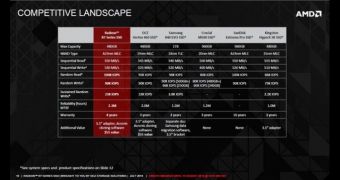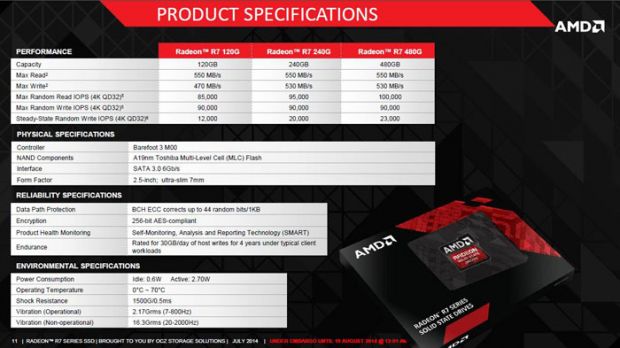The technology industry can be a really bizarre place sometimes, and it's times like this that people just have to stop and stare. Advanced Micro Devices has given us a reason to do just that: the Radeon R7 solid state drives.
You read it right. AMD, the Sunnyvale, California-based company, has prepared a collection of storage units that bear the same name as the company's mid-range graphics card lineup.
Why did AMD do this? No clue really. Probably because the Radeon brand is very strong and the company hopes to catapult its very young SSD business forward quickly.
Still, calling the SSDs the exact same thing as its graphics adapters and more than one integrated GPU boasted by A-Series APUs is odd.
Nevertheless, this is the situation. Or will be the situation whenever AMD gets around to marketing the things, which will still take a week.
According to reports on the net, the SSDs are expected to launch on August 13, 2014, but they still may not begin shipping for a few days afterwards.
The solid state drives bear the 2.5-inch form factor and communicate with PCs over the SATA III interface, also known as SATA 6.0 Gbps, due to its transfer speed.
Thanks to the OCZ Indilinx Barefoot controller chip and the use of Toshiba 19nm MLC (multi-level cell) NAND Flash chips, the SSDs can work very quickly indeed.
Specifically, sustained, sequential read speeds can go all the way to 550 MB/s, while writing speeds can reach 470 MB/s for the 120 GB drive and 530 MB/s for the 240/480 GB ones. It depends on the capacity, of course, but these are the upper limits. Not quite on the same level as SandForce-enabled drives, but closer than most.
Besides, it's not like SandForce-based SSDs actually reach 550 MB/s read and 540 MB/s write all that often in real life.
Anyway, the AMD Radeon R7 SSDs have capacities of 120 GB, 240 GB, and 480 GB. All three can attain random 4K performance of 85,000 IOPS, 95,000 IOPS, and 100,000 IOPS. Finally, 256 Bit AES encryption should be included.
Still about thirty times slower than the new, marvelous SSD technology that HGST introduced the other day, but the same can be said about every other SSD in the world. Unfortunately, AMD did not share what its pricing plans were for the newcomers.
The leak that says AMD is preparing this product line comes from Chinese tech site EXPReview.com. We suspect that Toshiba itself will release its own new SSDs soon, with comparable specs.

 14 DAY TRIAL //
14 DAY TRIAL // 

